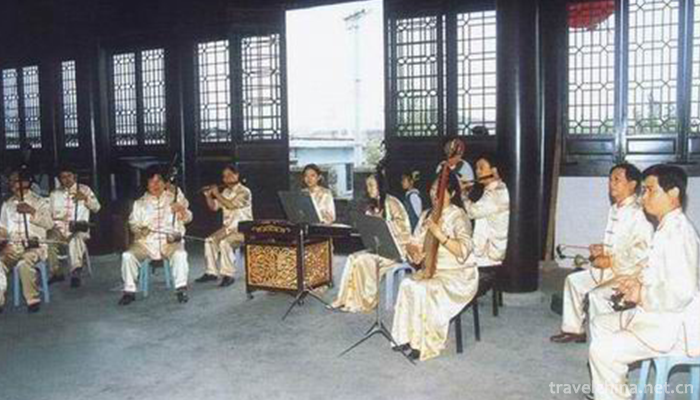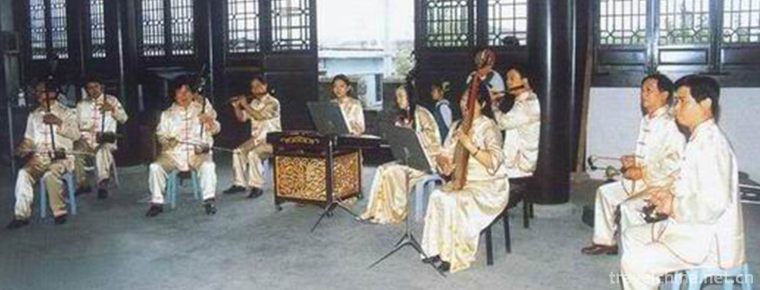Shaoxing Ci Tone
Shaoxing Ci Tone
Shaoxing Ci Diao, also known as Flower Diao, is commonly known as vernacular. It is a traditional folk song sung by blind artists (most of whom are women), and a story sung by three to nine people in different roles. It is a kind of folk art that transits from playing Ci to spreading reeds. It is popular in Shaoxing City of Zhejiang Province and its surrounding areas.
On June 7, 2008, Shaoxing Ci Tiao was approved by the State Council to be included in the second batch of national intangible cultural heritage list.
Historical Origin
The materials of the Song and Ming Dynasties all contain information about Shaoxing's singing art of "Blind Man Workshop" and "Village Blind Man... The record of "playing and singing words" and "playing and speaking words". Shaoxing Ci Diao's existing books (songs) and contents, Lyric forms, singing forms and so on, all reflect its inheritance relationship with the words and expressions flourishing in Yuan and Ming Dynasty, which is quite an ancient variety of folk art.
On December 12, 1916, Mr. Lu Xun's family sang Shaoxing Ci Tune, a "flower tune", to celebrate Lu Mu's sixtieth birthday. It can be seen that Shaoxing Ci Tune was very popular among the public at that time.
In the 1930s, Shaoxing Ci-tune flourished, with 50 or 60 artists; in the early 1950s, there were 22 artists registered; and in the mid-1960s, there were 10 artists.
Ten artists sang in the mid-1960s.
Traditional Bibliography
The traditional long bibliography of Shaoxing Ci Dialect has 18 old biographies, only 36 of which are lost seriously, and some of them are unique bibliographies of Shaoxing Ci Dialect, and there are still more than 50 "saving poems" (the opening part).
Inheritance Significance
Shaoxing has a long history of CI tunes, rich books (songs) and ancient versions. The singing music is simple and has a certain impact on the music of Hangzhou and Ningbo. But the artists are few and far between, and the music will be absolutely brilliant. Shaoxing's cultural department is stepping up its efforts to collect information and organize young actresses to learn and inherit.


-
1.Beigushan HillBeigu Mountain
Beigu Mountain, one of the three scenic spots in Zhenjiang, overlooks Beigu, pillows the river, rocky walls, and the mountain is dangerous, so it is named Beigu Mountain
Time 2018-12-06 -
2.Wuying National Forest Park
Wuying National Forest Park is located in Wuying District, Yichun City, Heilongjiang Province, about 19 kilometers away from the urban area. It is a concentrated protected area of Korean pine in China
Time 2018-12-22 -
3.Tongguan Yellow River Scenic Area
Tongguan Yellow River Scenic Spot is located at the famous ancient military pass-Tongguan ancient city, 140 kilometers away from Xi'an, only 20 kilometers away from Huashan
Time 2019-02-22 -
4.Production Techniques of Dezhou Braised Chicken
Dezhou Grilled Chicken is a kind of poultry meat product cooked slowly in small fire. It is originally produced in Dezhou City, Shandong Province. It is also known as Dezhou Wuxiang Boneless Grilled C
Time 2019-04-26 -
5.Legend of Yellow Crane Tower
The legend of the Yellow Crane Tower has a long history, and has been accompanied by the repeated destruction and construction of the Yellow Crane Tower
Time 2019-05-04 -
6.Construction Techniques of Hakka Tulou
Hakka Tulou building construction technology, Fujian Longyan City Nanjing County, Huaan County local traditional building construction technology, one of the national intangible cultural heritage.
Time 2019-05-09 -
7.Liyuan Opera
Liyuan Opera is one of the traditional operas in Fujian Province. Liyuan Opera originated in Quanzhou in the Song and Yuan Dynasties. It is also called "the voice of Fujian and Zhejiang" and
Time 2019-05-12 -
8.Qu Opera
Opera is one of the traditional operas mainly spread in Henan Province. It was also called "Gaotai Opera" or "Quzi Opera" in the old days. Quju is popular in Henan Province and its
Time 2019-06-11 -
9.Shaoxing Lotus Flower Fall
Shaoxing Lotus Fall, also known as Lotus Music and Lotus Fall, is a traditional form of folk art in Shaoxing, Zhejiang Province. It is named because of the help singing such as "Lili Lianhua Luo&
Time 2019-06-14 -
10.Wang Guo Festival
Wangguo Festival is a festival for Tibetan farmers to celebrate a bumper harvest. It is popular in Lhasa, Shigaze, Shannan and other places in Tibet Autonomous Region. The time is between July and Aug
Time 2019-06-26 -
11.Leshan Sports
In 2018, Leshan City organized a team to participate in the 13th Sichuan Provincial Games and won 19 gold medals, 25 silver medals and 47 bronze medals. 63 provincial-level sports fitness projects were established, and 279 municipal level national fitness
Time 2020-12-17 -
12.Meishan Sports
In 2019, 45 games will be held and 30000 people will participate in the games. At the end of the year, there were 116 sports associations. By the end of the year, there were 1410 sports venues in the education system. Meishan post and telecommunication
Time 2020-12-18